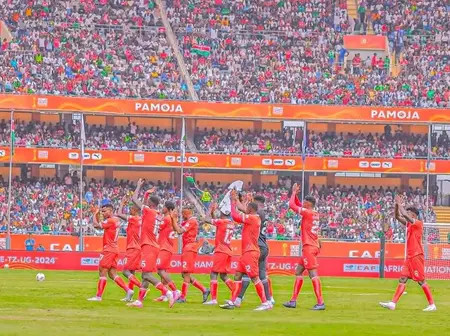From the moment the referee’s whistle blows, the magic of sport is not just on the pitch, it is in the stands-the terraces become a living, breathing sea of colour.
Flags wave like restless waves, songs rise like rolling thunder, and painted faces beam under the glare of stadium lights.
For many, the real theatre of a match is in the crowd, where fans turn support into a performance of its own.
Cheering is more than noise; it is a craft, a tradition, and an expression of loyalty that transforms ordinary games into unforgettable spectacles.
Moments after Harambee Stars stunned Morocco in the ongoing African Nations Championship (CHAN) tournament at the Kasarani stadium, coach Benny McCarthy dedicated the win to the fans.
In a post-match interview, McCarthy said the team could not have achieved the historic win without the fans.
“I am just proud of the players because they left everything on the pitch, not just for themselves but also for the fans in the stadium,” he stated.
“I don’t think if we didn’t have the performance from the fans we would have survived; not with 11 or 10 players,” he added.
“We owe this victory to the fans.”
The culture behind the noise
Cheering is as old as competitive sport itself.
Across continents, fans have developed their own unique ways of showing support, shaped by culture, tradition, and the sport in question.
In Brazil, football supporters turn stadiums into samba carnivals, with rhythmic drumming and choreographed chants that last the full 90 minutes.
In New Zealand, rugby fans unleash the spine-tingling haka, a traditional Māori war dance, before kick-off.
In Japan, baseball crowds sing organised fight songs for each player, complete with trumpets and drums.
While the style varies, the intent is the same, to lift the spirit of the team and intimidate the opposition.
It is a silent pact between players and their faithful: “We give you our all; you give us yours.”
Cheering styles: From chants to choreography
The most common form of cheering is chanting, repetitive, catchy lines shouted in unison to build rhythm and energy.
Some chants are short bursts, “Go! Go! Go!”, while others are elaborate, almost musical compositions with verses and choruses, “Ole! Ole! Ole! Oleee!”
Then there is call-and-response, where one section of the crowd shouts a phrase and another responds.
This keeps the energy bouncing around the stadium like an invisible ball.
In parts of Europe and South America, tifo culture adds visual drama.
Fans coordinate to hold up giant banners, mosaics, and flags that cover entire stands, often revealing powerful images or messages.
These displays are meticulously planned, sometimes taking weeks to prepare.
Some cheering is purely physical, the Mexican wave (la ola) rippling around a stadium, or rhythmic clapping that grows louder as a team pushes forward.
At times, the very act of standing and singing for the entire match is considered part of the ritual.
Tools of the trade: what fans bring
To the uninitiated, the sight of fans arriving at a game might feel like watching performers heading backstage.
They come armed with an arsenal designed to make their voices and presence impossible to ignore.
Flags and banners – From small handheld pennants to massive club-coloured flags, these are the visual identity of a supporter group.
Musical Instruments – Drums, trumpets, vuvuzelas, and even improvised shakers.
In some African matches, entire brass bands are in the stands.
A vuvuzela, also called lepatas or a stadium horn, is a blowing horn commonly used in soccer games in South Africa.
It was originally made out of tin and became very popular in South Africa in the 1990s.
In the 2010 World Cup, vuvuzelas were in the news all over the world because it was normal in South Africa for them to be blown at football matches.
The world football governing body, FIFA, did not want to allow the use of vuvuzelas.
This was because they were afraid that hooligans might use the instrument as a weapon and that businesses could put advertisements on vuvuzelas.
However, the South African Football Association (SAFA) said that vuvuzelas were important for South African games, and FIFA decided in July 2008 to let the instruments be used.
Some football players and audiences did not like the vuvuzelas.
The Lee Dixon of the BBC Three said that the sounds were “quite irritating”.
The European broadcasters also complained to FIFA that they could not hear the commentators because of the sound.
After the World Cup 2010, vuvuzelas started to be banned in other countries.
The Confederation of African Football (CAF), through Kenya’s Local Organising Committee (LOC), banned the use of vuvuzelas, whistles and drums during CHAN matches.
These restrictions are aimed at ensuring a tournament that adheres to the highest safety standards and is free from potential harm.
“Our objective is to foster a secure and exciting environment where everyone can enjoy the beautiful game,” a source from the LOC’s Safety and Security Department said.
Scarves and jerseys – Often held aloft during chants or worn proudly as a uniform of belonging.
Face and body paint – Turning skin into a canvas for team colours and slogans.
Megaphones – Used by “capos” (chant leaders) in supporter groups to coordinate songs and actions.
Some fans even bring symbolic items tied to superstition – lucky hats, mascots, or replica trophies, believing they help the team’s fortunes.
Why it matters
Players often credit the crowd as their “12th man.”
The noise can rattle an opponent’s nerves, lift a team’s energy, and even sway momentum in a match.
Studies in sports psychology suggest that home advantage is partly fuelled by crowd support, which can subconsciously influence referees’ decisions.
But beyond its impact on the pitch, cheering is about community. In the stands, strangers become allies.
Singing the same song, wearing the same colours, and celebrating the same moments creates a bond that outlasts the final whistle.

Leave a Reply